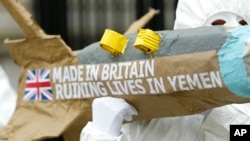A survey finds the United States is the world's top small arms trader in a multi-billion-dollar industry, followed by Italy, Brazil, Germany and South Korea.
The survey says at least $6 billion in authorized global arms trading took place in 2014, $200 million more than the year before.
It shows the U.S. bought fewer small arms in 2013 when purchases declined from $2.5 billion to $2.2 billion. Nevertheless, it says the U.S. remains the world’s largest importer of small arms, followed by Canada, Indonesia, Saudi Arabia and Germany.
The U.S. is also the top seller of small arms with exports of $1.1 billion in 2014.
The report also highlights the role of the least transparent small arms sellers. Iran, Israel, North Korea, Saudi Arabia and the United Arab Emirates got the lowest scores on the survey's transparency index of exporters.
Israel, for the first time, has scored zero points, while North Korea has consistently failed the transparency test. The report's authors warn the concealed nature of the small arms trade increases the chances small weapons will fall into the wrong hands and help fuel conflict and instability.
Small Arms Survey senior researcher Paul Holtom tells VOA it is hard to know who is receiving small arms and ammunition from places like North Korea.
“One assumes it is with the major recipients from North Korea in (the) 1980s, 1990s (who) have continued to be recipients. And, so there has been work carried out by the U.N. Panel of Experts on monitoring the sanctions on North Korea. It has highlighted a number of countries in sub-Saharan Africa that have received assistance in various forms," Holtom said. "Current investigations, I understand, are going on with regard to Namibia, with regard to small production that has been with Uganda, with Eritrea, with the Democratic Republic of Congo.”
Regarding regional trends, the survey finds between 2001 and 2014, the Americas accounted for 40 percent of documented global small arms imports, followed by Europe, Asia and the Pacific and Africa.
While the Africa region only imported 4 percent of small arms, the survey notes the value of trade there nearly tripled from $82 million to $237 million during that 13-year period.










